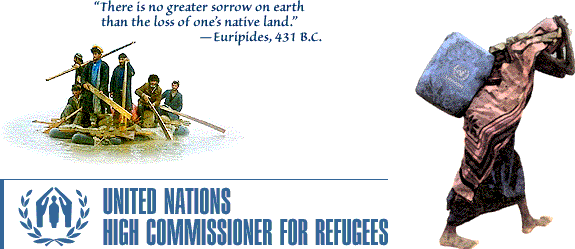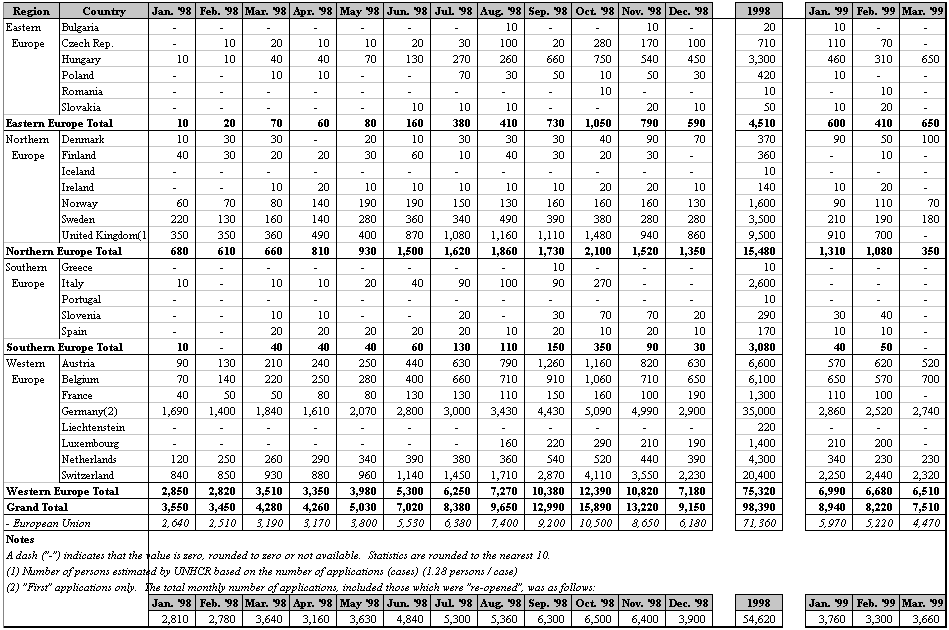AT A GLANCE
- About 2,000 refugees arrived in Macedonia and Montenegro on
Thursday despite the closure by Serbian authorities of border crossings.
- High Commissioner Sadako Ogata meets with NATO officials
and Macedonian government leaders, visits a refugee site in Macedonia on the third stop of
a tour of the region.
- Food deliveries have been stepped up into Macedonia and
Albania.
THE EXODUS
Despite the closure by Serbian authorities of
Kosovo’s borders, several thousand Kosovars managed to flee to neighboring areas.
About 1,200 refugees, marooned at a no-man’s land at
the Macedonia crossing at Jazince in Tetovo for two days, were moved to the Brazda refugee
camp on Thursday.
In Montenegro, nearly 1,000 people arrived from
Kosovo’s town of Istok, looking exhausted after a 13-hour walk. They were taken to
collective centers in Rozaje, where they received food, blankets and medical aid. Arrivals
at Rozaje proceed to Ulcinj, where tents are being set up for about 21,000 displaced
Kosovars there.
In Albania, the main border crossings at Morini and Qafe
Prushit remained closed since Belgrade declared a unilateral cease-fire on Tuesday. An
83-year-old man walked across Morini into Albania on Thursday. He repeated accounts by a
handful of people who had arrived earlier that there were no civilians on the road to
Albania, only Serbian troops and abandoned tractor-trailers and cars some of which had
been burned. At Morini, on the Albanian side, UNHCR saw Yugoslav soldiers digging trenches
and planting mines.
On Wednesday, a UNHCR team arrived in Macedonia to screen
those applying for humanitarian evacuation from Macedonia to third countries. Some 74,000
places have been offered in the West for Kosovars who might need to be moved to third
countries. UNHCRs priority continues to be to assist the refugees in the region, using
evacuation as a "safety valve."
On Thursday, 600 refugees were airlifted to Germany from
Skopje, 110 to Norway, 300 to Turkey and 13 to Switzerland. Evacuation plans for Friday
include 620 to Germany, 100 to Norway, 157 to Turkey and 22 to Bulgaria.
MRS. OGATA’S VISIT
On Friday, High Commissioner Sadako Ogata plans to meet
with the President of Macedonia and the Foreign and Labor Ministers in Skopje during the
third stop of her tour of the region. She also is to meet with NATO military officials and
visited the Brazda refugee camp. She extended her stay in Skopje for one day and is due to
return to Geneva on Saturday.
On Thursday, Mrs. Ogata met with Albanian leaders in
Tirana and later went by helicopter to Kukes in the north to look into the relief
operations there.
Mrs. Ogata told reporters in Kukes while she was alarmed
at the mass expulsions from Kosovo she was equally concerned about the sudden closure of
the borders. She added she hoped that force was not used to stop people from seeking
asylum. Recounting her meeting with refugees who recounted their flight from Kosovo, she
said: "There have been atrocities, no doubt, rape, beatings, burning of houses."
She said the extent of ethnic cleansing in Kosovo was worse than in Bosnia.
ASSISTANCE
Food supplies continued to arrive in the region.
In Macedonia, the World Food Programme announced Thursday
that a U.S.-funded 747 cargo plane on Wednesday night delivered 83,000 humanitarian daily
rations, or meals ready to eat, to Skopje from Paris. Two more 747 aircraft are planned to
airlift another 166,000 HDRs into Skopje on Friday.
A U.K.-funded transport plane was scheduled to deliver
from Norway to Skopje on Thursday 76,000 rations of canned fish and two tons of high
protein biscuits to feed 10,000 people a day. The consignment is part of a Norwegian
donation of 200 metric tons of canned fish and 200 metric tons of high protein biscuits.
In the past several days, U.S. air force planes have
delivered 160,000 daily rations into Tirana, Albania from Anacona, Italy.
The HDRs are part of the U.S. donation through WFP of 1.1
million daily rations — 600,000 for the refugees in Macedonia and 500,000 for
Albania.
|
 Kosovo
Crisis Update (09 April 1999)
Kosovo
Crisis Update (09 April 1999) Kosovo
Crisis Update (09 April 1999)
Kosovo
Crisis Update (09 April 1999)
 Document compiled by Dr S D Stein
Document compiled by Dr S D Stein